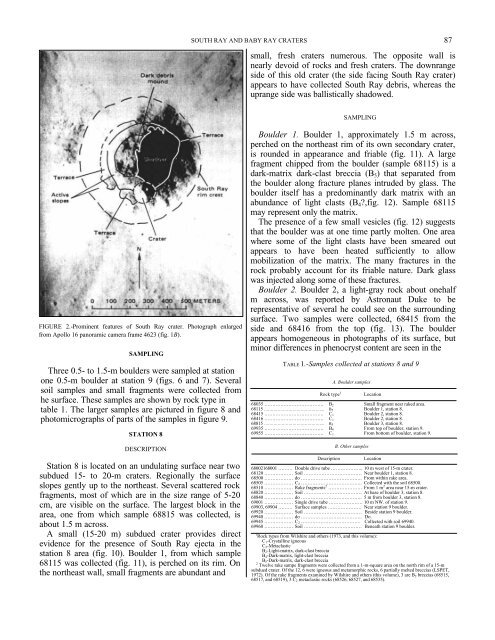d3. geology of areas near south ray and baby ray craters
d3. geology of areas near south ray and baby ray craters
d3. geology of areas near south ray and baby ray craters
You also want an ePaper? Increase the reach of your titles
YUMPU automatically turns print PDFs into web optimized ePapers that Google loves.
FIGURE 2.-Prominent features <strong>of</strong> South Ray crater. Photograph enlarged<br />
from Apollo 16 panoramic camera frame 4623 (fig. 1B).<br />
SAMPLING<br />
Three 0.5- to 1.5-m boulders were sampled at station<br />
one 0.5-m boulder at station 9 (figs. 6 <strong>and</strong> 7). Several<br />
soil samples <strong>and</strong> small fragments were collected from<br />
he surface. These samples are shown by rock type in<br />
table 1. The larger samples are pictured in figure 8 <strong>and</strong><br />
photomicrographs <strong>of</strong> parts <strong>of</strong> the samples in figure 9.<br />
STATION 8<br />
DESCRIPTION<br />
Station 8 is located on an undulating surface <strong>near</strong> two<br />
subdued 15- to 20-m <strong>craters</strong>. Regionally the surface<br />
slopes gently up to the northeast. Several scattered rock<br />
fragments, most <strong>of</strong> which are in the size range <strong>of</strong> 5-20<br />
cm, are visible on the surface. The largest block in the<br />
area, one from which sample 68815 was collected, is<br />
about 1.5 m across.<br />
A small (15-20 m) subdued crater provides direct<br />
evidence for the presence <strong>of</strong> South Ray ejecta in the<br />
station 8 area (fig. 10). Boulder 1, from which sample<br />
68115 was collected (fig. 11), is perched on its rim. On<br />
the northeast wall, small fragments are abundant <strong>and</strong><br />
SOUTH RAY AND BABY RAY CRATERS 87<br />
small, fresh <strong>craters</strong> numerous. The opposite wall is<br />
<strong>near</strong>ly devoid <strong>of</strong> rocks <strong>and</strong> fresh <strong>craters</strong>. The downrange<br />
side <strong>of</strong> this old crater (the side facing South Ray crater)<br />
appears to have collected South Ray debris, whereas the<br />
uprange side was ballistically shadowed.<br />
SAMPLING<br />
Boulder 1. Boulder 1, approximately 1.5 m across,<br />
perched on the northeast rim <strong>of</strong> its own secondary crater,<br />
is rounded in appearance <strong>and</strong> friable (fig. 11). A large<br />
fragment chipped from the boulder (sample 68115) is a<br />
dark-matrix dark-clast breccia (B5) that separated from<br />
the boulder along fracture planes intruded by glass. The<br />
boulder itself has a predominantly dark matrix with an<br />
abundance <strong>of</strong> light clasts (B4?,fig. 12). Sample 68115<br />
may represent only the matrix.<br />
The presence <strong>of</strong> a few small vesicles (fig. 12) suggests<br />
that the boulder was at one time partly molten. One area<br />
where some <strong>of</strong> the light clasts have been smeared out<br />
appears to have been heated sufficiently to allow<br />
mobilization <strong>of</strong> the matrix. The many fractures in the<br />
rock probably account for its friable nature. Dark glass<br />
was injected along some <strong>of</strong> these fractures.<br />
Boulder 2. Boulder 2, a light-g<strong>ray</strong> rock about onehalf<br />
m across, was reported by Astronaut Duke to be<br />
representative <strong>of</strong> several he could see on the surrounding<br />
surface. Two samples were collected, 68415 from the<br />
side <strong>and</strong> 68416 from the top (fig. 13). The boulder<br />
appears homogeneous in photographs <strong>of</strong> its surface, but<br />
minor differences in phenocryst content are seen in the<br />
TABLE 1.-Samples collected at stations 8 <strong>and</strong> 9<br />
A. Boulder samples<br />
Rock type 1 Location<br />
68035 ………………………………. B2 Small fragment <strong>near</strong> raked area.<br />
68115 ……………………………………... B5 Boulder 1, station 8.<br />
68415 ………………………………. C1 Boulder 2, station 8.<br />
68416 ………………………………. C1 Boulder 2, station 8.<br />
68815 ……………………………………... B5 Boulder 3, station 8.<br />
69935 ………………………………. B4 From top <strong>of</strong> boulder, station 9.<br />
69955 ………………………………. C1 From bottom <strong>of</strong> boulder, station 9.<br />
B. Other samples<br />
Description Location<br />
68002168001 ……… Double drive tube ……………….. 10 m west <strong>of</strong> 15-m crater.<br />
68120 ……………… Soil ……………………………… Near boulder 1, station 8.<br />
68500 ……………… do ……………………………….. From within rake area.<br />
68505 ……………… C2 ……………………………….. Collected with the soil 68500.<br />
68510 ……………… Rake fragments 2 ………………… From 1 m 2 area <strong>near</strong> 15-m crater.<br />
68820 ……………… Soil ……………………………… At base <strong>of</strong> boulder 3, station 8.<br />
68840 ……………… do ……………………………….. 5 m from boulder 3, station 8.<br />
69001 ……………… Single drive tube ………………… 10 m NW. <strong>of</strong> station 9.<br />
69903, 69904 ……… Surface samples ………………… Near station 9 boulder.<br />
69920 ……………… Soil ……………………………… Beside station 9 boulder.<br />
69940 ……………… do ……………………………….. Do.<br />
69945 ……………… C2 ………………………………. Collected with soil 69940.<br />
69960 ……………… Soil ……………………………… Beneath station 9 boulder.<br />
1Rock types from Wilshire <strong>and</strong> others (1973, <strong>and</strong> this volume):<br />
C1-Crystalline igneous<br />
C2-Metaclastic<br />
B2-Light-matrix, dark-clast breccia<br />
B4-Dark-matrix, light-clast breccia<br />
B5-Dark-matrix, dark-clast breccia<br />
2 Twelve rake sampe fragments were collected from a 1-m-square area on the north rim <strong>of</strong> a 15-m<br />
subdued crater. Of the 12, 6 were igneous <strong>and</strong> metamorphic rocks, 6 partially melted breccias (LSPET,<br />
1972). Of the rake fragments examined by Wilshire <strong>and</strong> others (this volume), 3 are B2 breccias (68515,<br />
68517, <strong>and</strong> 68519), 3 C2 metaclastic rocks (68526, 68527, <strong>and</strong> 68535).
















